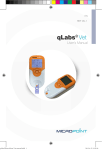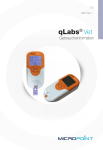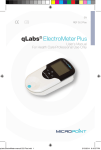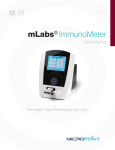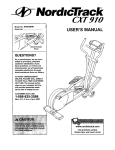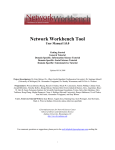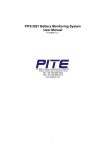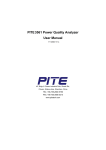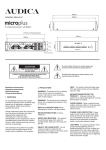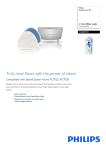Download qLabs® Vet Coag Panel 2
Transcript
qLabs Vet Coag Panel 2 ® QSV-1 Contains: 12 test strips QV-1 qLabs® Vet For Veterinarian Professional Use Only INTENDED USE INTRODUCTION The qLabs® Vet Coag Panel 2 test strip is designed to provide quantitative determination of Prothrombin Time (PT) and Activated Partial Thromboplastin Time (APTT). Blood coagulation or clotting is the process by which the blood changes from a liquid to form solid masses, or clots. It potentially results in hemostasis, the cessation of blood loss from a damaged vessel, followed by repair. Disorders of coagulation are disease states which can result in bleeding or obstructive clotting. Analysis of the blood coagulation can assist in measuring the integrity of the coagulation system and diagnosing disorders that can seriously affect the health of the patient. The qLabs® Vet Coag Panel 2 test is performed on the QV-1 qLabs® Vet instrument using fresh venous blood and citrated whole blood. It assists in the diagnosis and evaluation of excessive bleeding, hereditary bleeding disorders, disseminated intravascular coagulopathy (DIC), rodentacide poisoning, hepatic disease and monitoring therapy and progression of disease states. NOTES: • The qLabs® Vet Coag Panel 2 test strip is intended ONLY for in vitro veterinary diagnostic use. • It is suitable for professional use only. Blood clotting in the body is initiated through two pathways: the extrinsic and the intrinsic pathway. The extrinsic pathway is activated by external trauma that causes blood to escape from the vascular system. It involves factor VII and is quicker than the intrinsic pathway. The intrinsic pathway is activated by trauma inside the vascular system, and is activated by platelets, exposed endothelium, chemicals or collagen. This pathway involves factors XII, XI, IX and VIII and is slower than the extrinsic pathway. Both pathways meet and finish the pathway of clot production in what is known as the common pathway which involves factors I (fibrinogen), II (prothrombin), V and X. Two laboratory tests are used commonly to evaluate coagulation disorders: Prothrombin Time (PT) which measures the integrity of the extrinsic system as well as factors common to both systems and Activated Partial Thromboplastin Time (APTT), which measures the integrity of the intrinsic system and the common components. Specifically, the PT evaluates the presence of factors VII, V and X, prothrombin and fibrinogen, and APTT assesses the activities of the factors of fibrinogen, prothrombin, V, VIII, IX, X, XI and XII. The qLabs® Vet Coag Panel 2 test is designed and validated for determining Prothrombin Time and Activated Partial Thromboplastin Time on fresh venous blood and citrated whole blood of canine and feline patients. TEST PRINCIPLE qLabs® Vet Coag Panel 2 test strips are used together with the QV-1 qLabs® Vet. The meter automatically detects the insertion of a PT/APTT test strip and heats the strip up to a preset operating temperature. After a drop of blood is applied to the strip, the capillary channels carry the blood to the reaction zones, where the blood mixes with the pre-printed reagents and starts to coagulate. Each strip contains two reaction zones: one for PT testing, another for APTT testing. Each reaction zone contains one pair of metallic electrodes, to which a constant voltage is applied by the meter. As the coagulation of the blood proceeds, the current monitored across the two electrodes changes. The meter detects the change of the current in the reaction zone and identifies a clot endpoint for each of the two reaction zones. Based on analyses of the test data, the resultant clot endpoints for PT and APTT testing are converted to a PT value and an APTT value that is more familiar to the clinician, respectively. REAGENTS Each test strip contains a dual standardized amount of reagents on the test zones: recombinant thromboplastin, heparin neutralizing reagent, and stabilizers on the PT test zone, and phospholipid, particulate activator, stabilizers and buffers on the APTT test zone. An individual test strip is packaged in a pouch with one desiccant bag. PRECAUTIONS & WARNINGS • F or • • in vitro veterinary diagnostic use only. Do not take internally. F ollow proper infection control guidelines when handling all blood specimens and related items. U se fresh non anti-coagulated whole blood or citrated whole blood. Do not use plasma. • N ever add more blood to a test strip after the test has begun. •Do not move the meter during a test. • Do not use test strip that exceeds the marked expiration date or that has been stored improperly. The health status of the patient may affect the test. Please take this into consideration before making a therapeutic judgment based on the test results. Failure to do so may cause serious consequences. STORAGE & HANDLING The qLabs® Vet Coag Panel 2 test strip can be stored in the refrigerator at 2°C to 8°C or at room temperature (below 32°C) until the expiration date. Do not freeze. Store strips in their original foil pouch until ready to use. If refrigerated, allow the sealed pouch to come to room temperature for 5 minutes before opening it for testing. Use the test strip within 10 minutes after opening the foil pouch. TESTING PATIENT SAMPLES Material provided for testing fresh venous whole blood samples • QSV-1 qLabs® Vet Coag Panel 2 test strip Material provided for testing citrated whole blood samples • QSV-1 qLabs® Vet Coag Panel 2 test strip • qLabs® Re-Calcification Solution Material required, but not provided for testing fresh venous blood samples • QV-1 qLabs® Vet • 21-gauge needle or larger with 1.0 mL syringe • Sterile alcohol • Disposable glove • Puncture-resistant container for medical sharps • Sterile band aid • Bio-hazardous container Materials required, but not provided for testing citrated whole blood samples • • • • • Eppendorf tube rack 200 uL pipette and pipette tips Disposable glove Sterile alcohol Disposable venous blood lanet • 1.8 or 2.7 mL 3.2% (w/v) sodium citrate venous collection tube • Bio-hazardous container NOTE: Please refer to QV-1 qLabs® Vet User’s Manual to ensure you are using the test strips and the meter correctly. TEST PROCEDURE 1.Turn on the meter. 2.Remove a new Coag Panel 2 test strip from the foil pouch. 3.Insert the strip into the test strip guide. 4.Enter information to the meter as instructed by the User’s Manual. 5. Confirm the strip code which initiates warming-up of the meter. 6.Wait for the meter to warm up. When the warming-up is completed, you have 10 minutes to collect samples and start the test. 7.Collect whole blood samples and run test. 7.1 Collect fresh venous whole blood samples. 7.1.1 Clean the venipuncture site with alcohol and allow it to air-dry completely. 7.1.2 Collect >0.1 mL of venous blood into 1.0 mL syringe. 7.1.3 Remove the needle from the syringe. 7.1.4 Add one drop of blood to the sample port of the strip which initiates the test. Note: Do not exceed 20 seconds from venipuncture to adding blood sample. 7.2 Prepare citrated whole blood samples and run test. 7.2.1 Clean the venipuncture site with alcohol and allow it to air-dry completely. 7.2.2 Collect venous blood to a 1.8 or 2.7 mL 3.2% (w/v) sodium citrate tube and mix well. Important! Make sure that the blood level reaches to the correct filling line of the tube. Under- or over-filling of blood in the tube can cause inaccurate volume ratio of bloodto-citrate which leads to inaccurate results. After collection, mix the sample thoroughly by repeated inversion of the tube. Allow the sample tube to sit at room temperature for at least 1 minute before proceed to re-calcification step. After collection, the citrated sample should be tested within 2 hours when stored at room temperature or within 4 hours when at 4~8°C. 7.2.3 Remove a fresh re-calcification tube from the re-calcification reagent box and warm it up at room temperature for 4~5 minutes. 7.2.4 Tap the bottom of the tube against a lab bench, or use a centrifuge machine, to collect all the reagent liquid into bottom of the tube. Note: Make sure that all the reagent is collected into the bottom, otherwise it may cause incomplete re-calcification of the citrated blood which leads to inaccurate results. 7.2.5 Open the lid of the tube and fill in 200 uL of the citrated whole blood using 200 uL pipette. 7.2.6 Close the lid of the tube and mix the re-calcifying sample thoroughly by tapping it vigorously against fingers for at least 10 times. Alternatively, mixing of the re-calcifying sample can be carried out by inverting the tube slowly 10 times. Add 10 – 20 uL of the mixture 7.2.7 sample to the strip using the 200 uL pipette which starts the test. bio-hazardous container. 10.Dispose of the used strips and other contaminated items according to the local biohazard procedures. REFERENCE INTERVALS The reference intervals of PT and APTT for normal and healthy canine and feline by the qLabs test are as follows: Important! Accuracy of the qLabs test results is strongly dependent on quality of the samples which can be compromised by improper blood collection, inaccurate volume ratio of blood-to-citrate and incomplete mixing for re-calcification treatment. Precautions cited in the User’s Manual should be observed at all times to ensure good venous sampling process and citrated sample preparation. 8. Record the results when the test is completed. ® Species PT APTT Canine 14 – 20 s 94 - 123 s Feline 13 – 20 s 96 - 122 s Note: The reference intervals cited in this datasheet are established in line with those by the Quickvet PT/APTT combination test. LIMITATIONS 6. As with all diagnostic tests, qLabs® Vet Coag Panel 2 test results should be scrutinized in light of a specific patient’s condition and anticoagulant therapy. Any results exhibiting inconsistency with the patient’s clinical status should be repeated or supplemented with additional test data or repeated with other testing methods. RFORMANCE SPECIFICATIONS Category Performance Specification SYMBOLS Species Canine, Feline Sample type Non-anticoagulated venous whole blood or citrated whole blood Sample volume 10 ~ 20uL HCT 30% – 55% Time to results ≤ 420 sec Temperature limitation Reportable range 11 – 500 sec Lot number Reference Intervals Explanation In vitro diagnostics Name and Address of Manufacturer Canine: PT 14 – 20 sec APTT 94 – 123 sec Feline: APTT 96 – 122 sec PT 13 – 20 sec Symbols Expiry Date 1. The qLabs® system is designed to use fresh venous whole blood and citrated whole blood. Plasma should not be used. Precision PT ≤ 5% APTT ≤ 7% Do not reuse Operating temperature 10°C – 35°C Catalogue number 2. The drop of blood added to strips must be >10 μL. Operating humidity 10% – 90% Shelf life 12 months (15°C – 30°C) 3. Hematocrit ranges between 30% and 55% will not affect test results. 4. In vitro studies show no significant effect in blood samples containing up to 10 mg/ dL of bilirubin, 100 mg/dL of hemoglobin. 9.Dispose of the used syringes to sharps 10 minute out of pouch exposure of the strips at these conditions. 5. The qLabs® Vet Coag Panel 2 test strips are validated to perform at temperatures in the range 10 to 35°C, and 10 to 90% RH (relative humidity). This includes a ADDITIONAL INFORMATION If you have any questions regarding the use of this product, please call your local representative/ distributor or our customer service at +86 755 86296766. Contains sufficient for n tests Caution. Read carefully Micropoint Biotechnologies, Inc. 6F, No. 3, Industry 5 Road Shekou, Shenzhen, Guangdong China, 518067 www.micropointbio.com Tel +86 755 86296766 Fax +86 755 86673903 qLabs® and Micropoint® are registered trademarks of Micropoint Bioscience, Inc. ©2015 Micropoint Biotechnologies, Inc. All rights reserved. Printed in China. P/N 99040545409 Rev. A2


